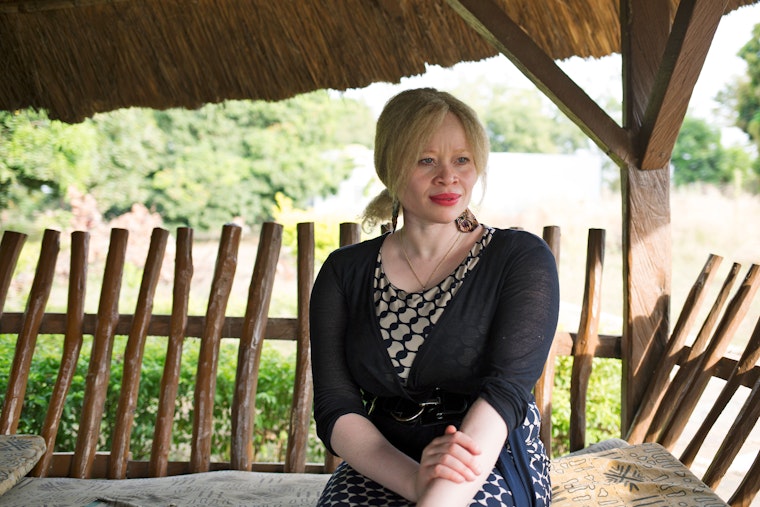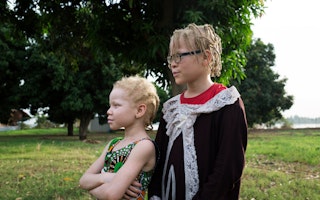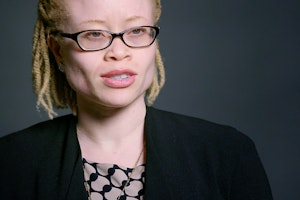Q&A: An International Movement for Albinism Rights

In some parts of sub-Saharan Africa, people with albinism are “in danger of extinction,” according to Ikponwosa Ero, the UN Independent Expert on the Enjoyment of Human Rights by Persons with Albinism. Ms. Ero, who has albinism and is the first person to hold her position, spoke with Alison Hillman, a senior program officer with the Human Rights Initiative, about efforts to help raise awareness about the crisis faced by people with albinism.
Let’s start by talking about your title. It’s long, even by UN standards!
It’s true. But it has a purpose.
The UN Human Rights Council created this mandate in 2015 to respond to increased reports of physical attacks on people with albinism.
Across Africa, people with albinism have been hunted down by those who want to harvest their body parts.
This is a macabre business. The limbs, hair, and even heads of people with albinism have been cut off by thieves and sold on the black market. More than half of these attacks have targeted children.
The rise in attacks came to light about 10 years ago, originating in Tanzania. Initially, it was thought that the harvesting of body parts and grave robberies were confined to a specific region of Tanzania, but over the past decade, reports of killings have spread to Malawi and Mozambique. Today, we have documented attacks in 28 countries across the continent.
Can you tell me more about the condition of albinism?
Albinism is a non-contagious, genetically inherited condition that results from insufficient production of melanin. It is characterized by the partial or complete absence of pigment in the skin, hair, and eyes, making persons with albinism appear pale in comparison with those with typical melanin production.
Both parents must carry the gene for a person to have albinism; in such cases, there is a 25 percent chance that their child will be born with albinism. In my case, I have five brothers and sisters—and I am the only one who has albinism. It’s sort of a genetic lottery.
Do people with albinism live all over the world?
Yes, there are some communities where the incidence of albinism is as high as one in a hundred. In Europe and North America, it is about one in seventeen thousand. In parts of the Pacific, it is as high as one in seven hundred. Many people are surprised to learn there are people with albinism all over the world. For example, I recently went to Japan and met persons with albinism there who routinely dye their hair, and even wear colored contacts in an effort to fit in.
What is driving these barbaric attacks against people with albinism?
Attacks are based on myths that the body parts of persons with albinism, when used in witchcraft potions, can help candidates win elections, or that these potions will bring luck in romance, and lead to success for business people.
So, body parts are harvested and sold to witch doctors?
Yes, according to the International Red Cross [PDF] and media reports, this can be quite lucrative. A limb can sell for $5,000 and a full corpse for $75,000.
Other than impacting your appearance, does albinism have other health impacts?
In addition to affecting appearance, albinism often results in two congenital permanent health conditions: visual impairments to varying degrees and high susceptibility to skin cancer. For instance, if a person with albinism does not use sunscreen, they are at significant risk of contracting very aggressive forms of skin cancer. There are indications that people with albinism in tropical countries, for example, are dying at a stunning rate due to skin cancer.
The saddest part is that it is entirely preventable. Simply using sunscreen is an effective way to protect yourself. Statistics show as many as 98 percent of the people with albinism in some countries are dying before the age of 40 due to exposure to the sun.

I know many organizations of persons with albinism identify as part of the disability rights movement. How does albinism fit within a disability framework?
Historically, many people understood disability in a very limited sense. Wheelchair users, people who are blind or hearing impaired are what people typically thought of when they imagined a person with a disability.
Now, thanks to the widespread adoption of the UN Convention on the Rights of People with Disabilities, we understand disability as the interaction between a person’s impairment and the barriers in society that limit full inclusion and participation in our communities. For persons with physical disabilities, lack of accessible transportation and infrastructure are the barriers. For persons with albinism, for instance, the barriers are lack of accommodations in the classroom and the attitudes and beliefs that many people have about persons with albinism that exclude us from education, the labor force, and even threaten our lives.
Because of the Convention on the Rights of People with Disabilities, governments have the responsibility to remove barriers so that persons with disabilities can participate on an equal basis with others in their communities, and this includes deconstructing physical, communicational, and attitudinal barriers.
So what is a concrete example of an action a government can take to promote the inclusion of persons with albinism?
Providing sunscreen is a simple, low-cost example. I do not have skin cancer because I have had access to sunscreen. In many countries where people with albinism live, sunscreen is either unavailable or too expensive for them to buy. We are working in a number of countries with governments to begin production and offer the creams to people with albinism at little or no cost.
Adequate police training is another. In many places, police do not understand the particular risks persons with albinism face and, as a result, they have not taken simple, common sense precautions to help prevent attacks.
Governments can also conduct awareness-raising campaigns. In many African countries, there is a myth that persons with albinism “don’t die, they disappear.” This is linked to the practice of infanticide; children with albinism are killed at birth to avoid the shame and stigma that often accompanies having a child with albinism. Government-sponsored campaigns showing persons with albinism in everyday life, participating as anyone else would, would go a long way to deconstructing some of the myths and stereotypes that keep us sidelined and even threaten our lives.
We are not talking about solutions that are expensive. I come from a developing country so I am sensitive to the costs and the burdens that governments face.
Tell me what success would look like for you given your mandate.
My mandate exists to spread awareness about the rights violations that persons with albinism face and inspire governments to take concrete steps to address these violations and promote our rights.
In 2017, a regional action plan to address abuses and promote rights was adopted by the African Union. This has already been a big success, but going forward I want governments to implement national action plans that respond to the needs in their countries.
With partners across Africa, we are also working to build the movement of organizations of persons with albinism so that they can advocate for their rights and be part of the solution to this human rights crisis.
Finally, I hope more people become aware of this crisis and take action to change attitudes and end abuses. We have established an interactive website actiononalbinism.org where people can find more information and become change agents. Get involved!

